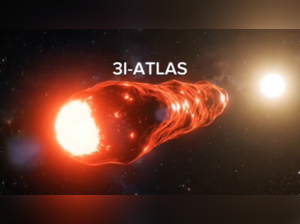Science
Scientists Unveil Surprising Details of 3I/ATLAS Interstellar Object

The interstellar object known as 3I/ATLAS has emerged as a subject of intense scientific scrutiny following the revelation that it is significantly larger and more massive than previously estimated. First detected by NASA on July 1, 2023, 3I/ATLAS is the third known interstellar visitor, following 1I/‘Oumuamua in 2017 and 2I/Borisov in 2019.
Research led by Harvard astrophysicist Avi Loeb and his team indicates that the mass of 3I/ATLAS exceeds 33 billion tons. This calculation was derived from analyses of the object’s trajectory and gravitational acceleration, measured at less than 49 feet per day squared. By examining the gases and dust it sheds, scientists were able to refine their estimates of its size.
New data suggests that the diameter of 3I/ATLAS’s solid-density nucleus is larger than 3.1 miles, surpassing projections made by the Hubble Space Telescope. These findings imply that 3I/ATLAS is considerably more massive than both 1I/‘Oumuamua and 2I/Borisov, marking it as an unusual cosmic entity.
Uncommon Characteristics of 3I/ATLAS
Loeb emphasized the significance of discovering such an object, noting that scientists should have identified thousands of interstellar objects comparable to ‘Oumuamua before encountering one like 3I/ATLAS. The scarcity of such findings enhances the intrigue surrounding this remarkable body.
Currently, 3I/ATLAS is traversing the solar system on a trajectory that will bring it near Jupiter, Venus, and Mars. It is projected to pass within 1.67 million miles of Mars’ orbit around the Sun. Despite its immense size and high speed, scientists have confirmed that it poses no threat to Earth.
Possible Theories on 3I/ATLAS
A controversial hypothesis proposed by Loeb and his colleagues suggests that 3I/ATLAS may not be a natural celestial body but rather a technological artifact created by extraterrestrial intelligence. In a paper published on July 17, 2023, they speculated that if 3I/ATLAS is indeed artificial, it could have benign or hostile intentions.
The researchers based this theory on the object’s non-gravitational acceleration and its unusual trajectory as it approaches Venus, Mars, and Jupiter. They noted that the low retrograde tilt of 3I/ATLAS, which allows it to spin in a direction opposite to most solar system bodies, may enable it to approach Earth without significant obstacles.
According to Loeb, this pathway and tilt could allow for the potential observation of planetary orbits and masses, which might inform a strategy for any intelligent life aboard the object. While this hypothesis remains unverified, it brings forth important questions regarding interstellar exploration and the potential for contact with extraterrestrial beings.
In summary, the study of 3I/ATLAS continues to intrigue scientists and spark debate, as they work to understand the true nature of this extraordinary interstellar visitor.
-

 World5 months ago
World5 months agoSBI Announces QIP Floor Price at ₹811.05 Per Share
-

 Lifestyle5 months ago
Lifestyle5 months agoCept Unveils ₹3.1 Crore Urban Mobility Plan for Sustainable Growth
-

 Science4 months ago
Science4 months agoNew Blood Group Discovered in South Indian Woman at Rotary Centre
-

 World5 months ago
World5 months agoTorrential Rains Cause Flash Flooding in New York and New Jersey
-

 Top Stories5 months ago
Top Stories5 months agoKonkani Cultural Organisation to Host Pearl Jubilee in Abu Dhabi
-

 Sports4 months ago
Sports4 months agoBroad Advocates for Bowling Change Ahead of Final Test Against India
-

 Science5 months ago
Science5 months agoNothing Headphone 1 Review: A Bold Contender in Audio Design
-

 Top Stories5 months ago
Top Stories5 months agoAir India Crash Investigation Highlights Boeing Fuel Switch Concerns
-

 Business5 months ago
Business5 months agoIndian Stock Market Rebounds: Sensex and Nifty Rise After Four-Day Decline
-

 Sports4 months ago
Sports4 months agoCristian Totti Retires at 19: Pressure of Fame Takes Toll
-

 Politics5 months ago
Politics5 months agoAbandoned Doberman Finds New Home After Journey to Prague
-

 Top Stories5 months ago
Top Stories5 months agoPatna Bank Manager Abhishek Varun Found Dead in Well









